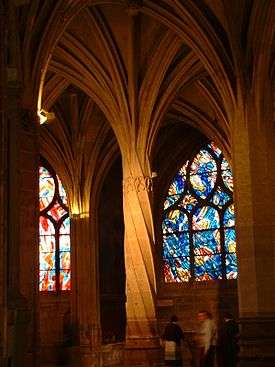Saint-Séverin, Paris
The Church of Saint-Séverin (French: Église Saint-Séverin) is a Roman Catholic church in the Latin Quarter of Paris, located on the lively tourist street Rue Saint-Séverin. It is one of the oldest churches that remains standing on the Left Bank, and it continues in use as a place of worship. It was on this burial ground that the first recorded surgery for gallstones was performed in 1451 by Germanus Collot.

History
Séverin of Paris, a devout hermit, lived on the banks of the River Seine during the first half of the fifth century. The oratory which was built over his tomb became the site of a small Romanesque church which was built around the eleventh century. As a result of the rapidly expanding community on the Left Bank, it was decided a larger church was required. The new structure, built at the beginning of the thirteenth century in the Gothic style, had a nave with lateral aisles. An additional aisle on the south side was built in the early 14th century to accommodate the growing congregations from the nearby university.[1]

After the church was seriously damaged by fire in 1448 during the Hundred Years' War, the archpriest Guillaume d'Estouteville rebuilt the church in the Late-Gothic style, adding a new aisle to the north. In 1489, a semi-circular apse was added at the eastern end with an ambulatory complete with columns including the strangely coiled central pillar. Additional space was provided by constructing chapels along the outer aisles. After their completion in 1520, the church took on the general appearance it still has today. In 1643, a second sacristy was added and in 1673, the royal architect Jules Hardouin-Mansart built the Communion chapel on the church's southeast corner. In 1684, the decorator Charles le Brun modified the design of the choir, removing the rood screen and providing the apse columns with marble facing.[1]
Exterior
The church's external features include some fine gargoyles and flying buttresses. Its bells include the oldest one remaining in Paris, cast in 1412; their ringing is recalled in a well known poem in praise of Paris by Alan Seeger.
There is a flamboyant rose window above the west entrance. The large Gothic portal under the bell tower was transferred from the church of St-Pierre-aux-boeufs which was demolished to create a new street. Its relief depicts St. Martin dividing his cloak.[1]
Interior
Internal features of the church include both ancient stained glass and a set of seven modern windows by Jean René Bazaine (1970), inspired by the seven sacraments of the Catholic church, around the ambulatory.[2] The deambulatory also includes an unusual pillar in the form of the trunks of a palm tree, that brings to mind the Apprentice Pillar at Rosslyn Chapel. The construction of the marble choir was made possible by donations from Anne, Duchess of Montpensier, a cousin of Louis XIV. The organ is signed Jean Ferrand.
Until 1790 Saint-Severin was the seat of the southern archdeaconry of the pre-revolutionary diocese of Paris. In the late nineteenth century the writer Joris-Karl Huysmans frequented and popularised the church. At Michaelmas 1956 it was the scene of a demonstration by Christian conscripts against the war in Algeria. In the years leading up to the Second Vatican Council Saint-Severin was known for the style of its worship arising from the Liturgical Movement.
Recent curés have included
- Daniel Pézeril, subsequently auxiliary bishop of Paris
- Maurice Le Bègue de Germiny, currently bishop of Blois
- Jérôme Beau, currently auxiliary bishop of Paris
The address of the church is 3, rue des Prêtres Saint-Séverin, 75005 Paris, France.
References
- "Church tour in English", Paroisse Saint-Séverin. Retrieved 24 July 2012.
- William-Jean de Vandière, Colette Marsin, Gérard Guillier: "Seven centuries' stained glass windows in the Saint-Séverin Church", undated booklet, 25 p.
External links
| Wikimedia Commons has media related to Église Saint-Séverin (Paris). |